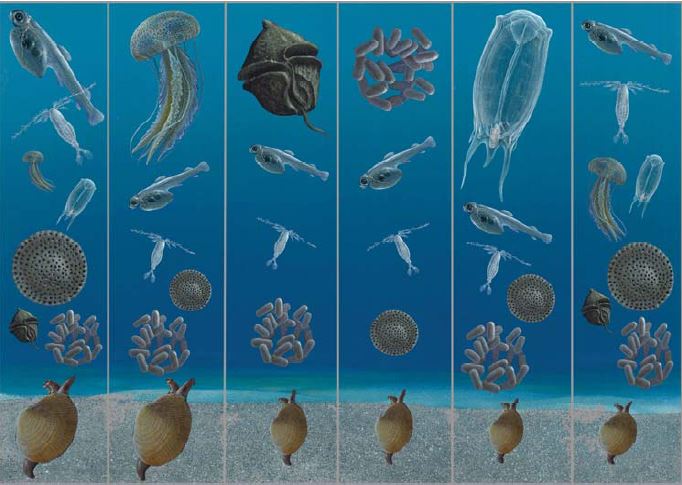2.3 Lessons from the history of the Adriatic Sea
During the Pelagia years, the Adriatic Sea was particularly struck by the blooms, with lots of studies by Italian, Slovenian and Croatian researchers (see CIESM, 2001 for references). As described by Boero (2001) and Boero and Bonsdorff (2007), Pelagia blooms eventually came to an end, to be replaced by a period of red tides, caused by dinoflagellate blooms, coupled with events of anoxic crises, followed then by a period of mucilages (Fig. 14).

Figure 14. Ecological history of the Adriatic Sea. Period 1: fish-dominated. Period 2: jellyfish dominated. Period 3: dinoflagellate-dominated (red tides), with overfishing of benthic molluscs. Period 4: bacteria-dominated, with mucilages. Period 5 (erratic): thaliacean-dominated. Period 6 (present): lower production (art by A. Gennari, graphics by F. Tresca).
The scenario hypothesized by Boero (2001) and Boero and Bonsdorff (2007) was that the persistence of Pelagia blooms in the first half of the 1980s had a similar effect to that of Mnemiopsis in the Black Sea, but that the real impact of the blooms was not properly evaluated. Fishermen lamented net clogging by jellyfish aggregates, so impairing their functioning. This interpretation of jellyfish impact on fisheries presumed that the fish were there, but that they were not caught because the jellyfish impaired fishing gears. In the Black Sea, instead, Mnemiopsis did not clog fishing nets, and it was immediately apparent that fish were not caught simply because there were no more fish! Pelagia is a very efficient predator of fish eggs and larvae, and of their crustacean food (see, for example Sabates et al., 2010) and it is highly probable that fish populations were depleted by Pelagia predation during the early 1980s blooms. Jellyfish replaced a very important sink of carbon fluxes (i.e. fish), as it happened many times in the past, at more or less regular intervals (Goy et al., 1989). Past Pelagia blooms, however, were not so devastating as those of the 1980s and did not lead to the same series of phase shifts that affected the Adriatic Sea in the 1980s (Fig. 14). Fish, in fact, are longer lived than jellyfish and the nektonic food webs they form are very complex and partly self-sustained, since large fish feed on smaller fish, getting much farther from the base of trophic networks than jellyfish. During their blooms, jellyfish first draw most energy from the system and then go through massive mortalities, at the end of the favorable period. Large fish are almost immune to jellyfish predation and even if they skip one reproductive event, they still have time to engage successful reproduction when the jellyfish eventually disappear. The success of jellyfish, in this framework, is temporary, and the fish dominate the scene again as soon as jellyfish decrease. As remarked above, jellyfish blooms might even be beneficial to fish populations, playing a keystone role in avoiding the monopoly of few species ensuing from abnormal reproductive success. Fish, however, are subjected to another predatory pressure, at the other end of their life cycles. Humans catch adult fishes with increasingly efficient gear. This pressure on the adults might be compensated by the very high fecundity of teleosts, so that even a few remaining adults can repopulate the oceans with their astonishing production of eggs and larvae.
Fish, then, are well equipped to cope with gelatinous predators, escaping them with the larger size of their adults and with longer life spans than those of gelatinous plankton. Fish are also well equipped to cope with human predation, due to their small size at the beginning of their life cycle and to their very high fecundity rates. But if the attack to fish occurs at both sides of the spectrum, with gelatinous plankton decimating the eggs, larvae, and juveniles and predating on their crustacean food, and with fisheries decimating the reproductive adults, then the defeat of fish might be more serious than when "attacks" are isolated.
The reason for the defeat of fish in the Adriatic history of the 1980s and 1990s might be just due to gelatinous plankton blooms coupled with overfishing. A series of Pelagia blooms disrupted the recruits of Adriatic fish and overfishing reduced the reproductive adults to a threshold that made recovery of fish populations less effective than in the past. Of course, as already stressed, multiple causality is paramount in determining these events, and surely also pollution and eutrophication did play a relevant role in determining the state of the Adriatic Sea. The series of phase shifts in the Adriatic Sea history, with an amazing phylogenetic regression in the dominance of Adriatic biota (fish, jellyfish, dinoflagellates-red tides, bacteria-mucilages) might well be due to the disruption of the food web based on the microbial loop, continuing to crustaceans, and then ending up into fish larvae and juveniles, sustaining nektonic food webs and, hence, fisheries. In the past, the system could cope with episodes of jellyfish abundance, but in the case of the early 1980s blooms, the system went in another direction and is still not back to what was "normal" in pre-Pelagia years.
Another outstanding case of jellyfish outbreak in the Mediterranean is that of Rhopilema nomadica in the Levantine Basin (see below).